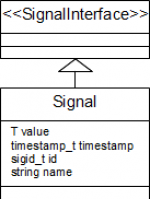This is an old revision of the document!
Signals
A signal represents a succession of varying physical quantities over time as used in signal processing and control. It has certain properties, such as a value and a timestamp, indicating the exact time corresponding to the value of the represented physical quantity. This is usually when the value was captured or generated.
Properties
Each element of a signal is characterized by a value, a high precision timestamp, a name and additional properties, depending on the type of signal, which will provide semantic information. Some examples are dimension (e.g. length, mass, current, etc.), SI-unit (e.g. m, m/s, kg, Nm, A, etc.), reference coordinate system or activation state (enabled/disabled). Other properties could include information about the quality of the signal like noise or quantification which could be used for Kalman filtering.
It's important to note that a signal can carry a single value as well as a vector or matrix of values. For this purpose the field value is declared as of type T. Signals are used to connect different blocks in the control system and share information between the control system, the sequencer and the safety system.
Using Signals
The example below shows a gain block being defined, where its input and output are set to a two dimensional vector. Its gain is therefore a 2×2-matrix.
Gain<Vector2, Matrix<2,2>> g1({1,2.5,-1,-0.5});
If a Gain block is declared with a simple value, a eye matrix with this value is created internally.
Gain<Vector2> g1(10);
In order to access the individual dimensions of a certain signal, use functions like
sum.getOut().getValue(); // returns dimension 0 of output sum.getOut().getValue(0); // returns dimension 0 of output sum.getOut().getValue(2); // returns dimension 2 of output sum.getIn(1).getValue(2); // returns dimension 2 of input 1

